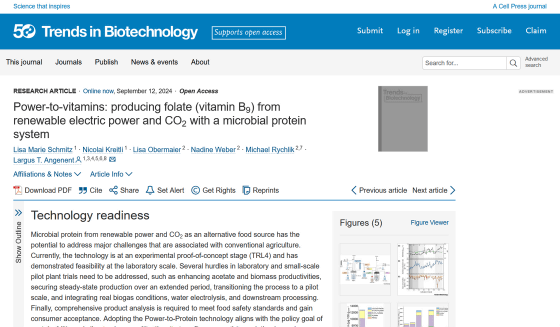Researchers develop a system that uses yeast to produce proteins and vitamins from water and air

At the time of writing, the Earth's population is said to be about 8.1 to 8.2 billion people, and is
Power-to-vitamins: producing folate (vitamin B9) from renewable electric power and CO2 with a microbial protein system: Trends in Biotechnology
https://www.cell.com/trends/biotechnology/fulltext/S0167-7799(24)00177-X

Powered by renewable energy, microbes turn CO2 into proteins and vitamins | ScienceDaily
https://www.sciencedaily.com/releases/2024/09/240912135704.htm
'The world's population is approaching 10 billion, but climate change and limited land resources are making it increasingly difficult to produce enough food,' said Largus Angenend , professor of applied microbiology at the University of Tübingen in Germany. 'One alternative is to grow proteins in bioreactors based on biotechnology, rather than growing crops to feed animals, which would make agriculture more efficient.'
So Angenent and his team designed a two-stage bioreactor to produce yeast rich in protein, an essential nutrient for building muscles, organs, skin and hair, and folate, a key nutrient that helps produce red blood cells and is involved in metabolism.
The bioreactor that the research team devised first produces acetate by feeding hydrogen and carbon dioxide to the bacterium Thermoanaerobacter kivui , and then feeds acetate and oxygen to Saccharomyces cerevisiae, known as baker's yeast, to produce proteins and folic acid.
The hydrogen and oxygen needed for this reaction can be produced by electrolyzing water using electricity generated from clean energy sources like windmills, the team claims.

The researchers found that the yeast produced almost the same amount of folic acid when fed acetate as when fed sugar, and that just 6 grams of the dried yeast they harvested met the daily recommended intake of folic acid.
It was also found that the amount of protein produced by S. cerevisiae is greater than that of the same weight of beef, pork, fish, lentils, and other foods. 85g of dried yeast contains about 61% of the daily required protein, which is significantly more than the same weight of beef (34%), pork (25%), fish (38%), and lentils (38%).
However, S. cerevisiae contains compounds that increase the risk of gout if consumed in excess, so it must be treated before consumption to remove these compounds. Even so, 85g of treated yeast still contains 41% of the daily protein requirement.
'It's a fermentation process similar to how we make beer, but instead of feeding the microorganisms sugar, we feed them gas and acetate,' Angenent said. 'We knew that yeast could make folic acid from sugar, but we didn't know if they could do the same with acetate.'

The bioreactor invented in this study runs on clean energy, water and carbon dioxide, reducing the carbon footprint of food production and helping to protect the environment by requiring less land than livestock farming or agriculture.
'The fact that we can make vitamins and proteins at the same time without using land and with a fairly high efficiency is exciting,' Angenent said. 'The final product is edible for vegetarians and vegans, is non-GMO and sustainable.'
Related Posts:







